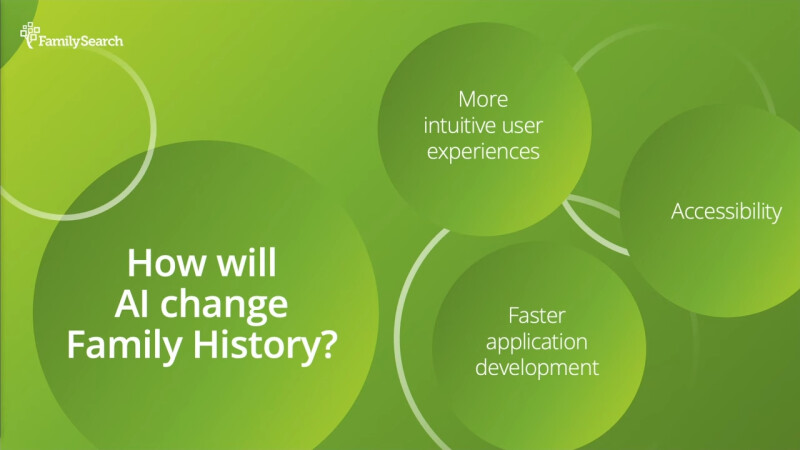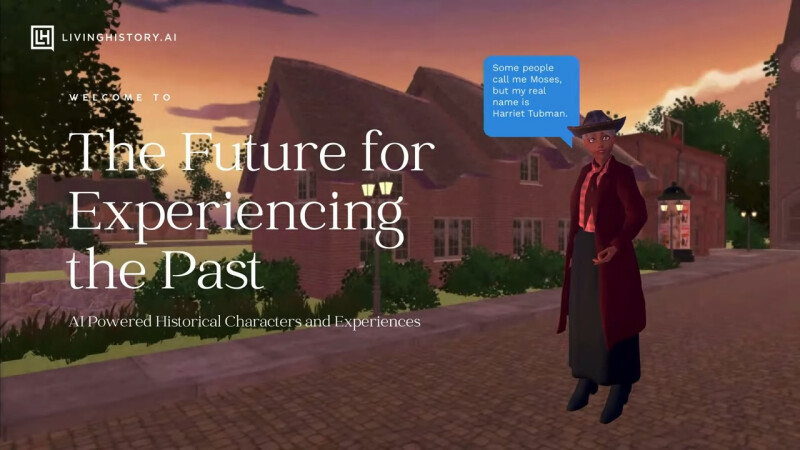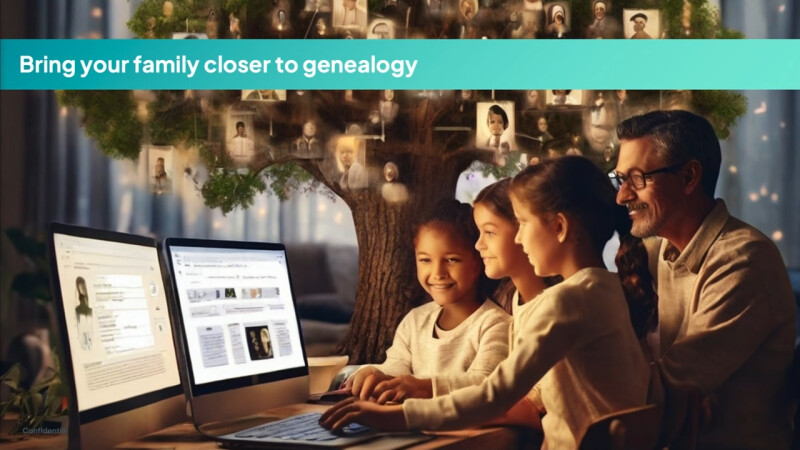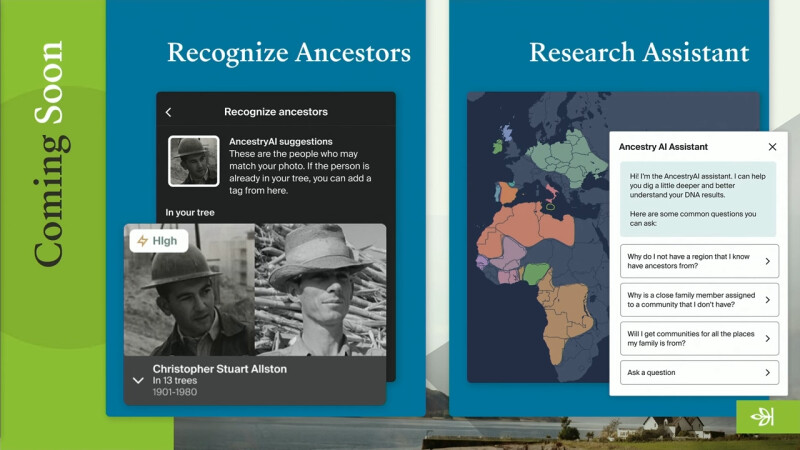The Innovation and Tech forum at the 2024 RootsTech conference intensely focused on how Artificial Intelligence (AI) is changing genealogical research. That these are early days for AI was a prevailing message. Exciting new technologies are being developed, and challenges and shortcomings are being overcome. For example, when you ask an AI to create a family logo for a reunion, it doesn't even come close to spelling your name correctly.
Since opinions vary greatly on AI as a topic, the RootsTech team gauged the forum audience by offering a survey. “We’re using technology to show how cool technology is,” said RootsTech emcee Kirby Heyborne, as he offered a QR code for the crowd to scan. The question RootsTech asked was, “How much do you understand about Artificial Intelligence?”
Participants' answers appeared in real time, showing that just over half of the audience felt like they knew nothing or a little about AI; around 40% felt like they knew more than most; and about 6% counted themselves as experts. These percentages would change drastically when the crowd was re-surveyed at the end of the forum.
Brought in as the forum’s opening speaker and also an expert on AI, Jared Spataro, Microsoft VP and leader of their Modern Work and Business Applications team, then spoke, beginning the hour-long forum with a thorough primer, allowing a better understanding (what some might even call a demystification) of AI.
More dazzling examples of how and why AI is important in the genealogy field then came from a half dozen presentations of top industry visionaries, whose insights and ideas often surprisingly reinforced each others.

Spataro affably covered the basics of Artificial Intelligence in his address, keeping in mind the audience’s varied levels of familiarity. He reminded the audience of how, less than 2 years ago, most of us had not been exposed to generative AI, with the advent of Chat GPT happening only in November of 2022.
“Think back to the first time that you saw Chat GPT in action, saw what it could do,” he said. “Perhaps it was a party trick at a holiday table.” That was the first time that generative AI had been given to millions of people around the world. People discovered that AI is a tool that can create compelling, original content on demand. Again, the mystery of what it is and how it works comes up.
“Well, it all starts with you,” Jared declared. "You direct AI to create content by typing a question or instructions into a chat box, and this is called a prompt. You don't need to know any technical language, because generative AI works using just your own words. The basic model involves 3 things: your prompt, an AI orchestrator, and an LLM. Your prompt tells the orchestrator to pull relevant information from that LLM, or what we call a Large Language Model.”
The remainder of Spataro's demonstration helpfully explained the relevant AI acronyms in ways that are easy to understand. He also showed some examples of the differences between older AI and newer AI, showing many of the things Microsoft Copilot can do.
For example, while both old and new AI can give "5 suggestions for helping someone learn to do family history," it often would have challenges when asked current event questions. He displayed Copilot's abilities with generating images, creating translations, and more (including a fun example of generating a song about family history from scratch).
“Now, it's worth repeating that Copilot doesn't always get it right,” Jared reminds us. “It does sometimes make mistakes. After all, it is not autopilot. It is your co-pilot. But sometimes it just completely blows your mind. There is no denying that the promise is very real. Based on the feedback from early users, we're already seeing the ways it can make us more productive, more creative, and ultimately help us spend more of our time on the things that matter most to us.”
To see for yourself:
Visit the Product Website
View the Innovator's Presentation

"Despite the name, AI really isn't that intelligent," he says. "It is pretty amazing, but it's not intelligent the way that people are."
He explained that, in essence, AI programs can learn to accomplish tasks through examples and patterns—lots of them. On the strength of his own understanding of AI and the demonstrations of Spataro, the previous speaker, he offered 3 areas he believes that AI is fundamentally going to change family history:
First, he said, "I believe AI will allow us to create user interfaces that are more natural for people to use....AI in particular is really good at understanding what we mean instead of what we say."
"Second, I believe that AI will bring family history to a broader audience. For example, imagine somebody who can't read or write doing family history on a smartphone.
"And third, AI is already accelerating the pace at which developers can write and test the applications that you use."
John showed a few brief examples of AI helping with family history. He spoke of how FamilySearch is using AI to accelerate transcribing historical records and assisting users on the site.
Try Upcoming FamilySearch Products
View the Innovator's Presentation
You can also learn more about FamilySearch's current AI projects by watching the FamilySearch Tech Forum, also available from RootsTech 2024.

Living History uses technology to create custom, immersive historical experiences so you and your audiences can meet with historical figures and ancestors, perhaps even that one person from the past that you are thinking of. "You can ask them about their life, have them tell you a story, or even ask them for advice," Jonathan explained. He showed an example of an interaction with Harriet Tubman, shown as an animated avatar, rather like you would find in a lifelike video game. The objects and environment around the figure or ancestor you are meeting can also be interacted with, combining to give a powerful experience.
The After Life, its companion website, lets you see an immersive 3D version of a family tree by combining AI and the FamilySearch API. You can see in 3D what you're used to seeing in 2D. We're talking about a 3D family tree up to 16 generations. See all the gaps and sort by age, century, birthplace, number of children, and so on. Clicking on an ancestor transports you to an experience where you can see images, text, and audio files pulled from your family tree on FamilySearch.
To learn more:
Visit the Living History Website
Visit the After Life Website
View the Innovator's Presentation

"Historical biographies provide a unique and detailed insight into the story of the individuals and their lives," he said. "But it's challenging!"
The challenge is to find the stories and integrate them into our family tree, requiring loads of transcription effort. Using AI, Storied has developed methods for scanning and transcribing these biographical documents. The biography extraction technology identifies individuals, their key life events, relatives, or other people mentioned. Once identified, the relationships appear in a graph, creating a family and nonfamily view of names mentioned.
"We can then send your hint onto your tree, to let you know we found something interesting so that you can go look at it without all that keyword soup searching," he explained.
"Once you attach these facts and their source to the tree, you can take the most interesting parts of the biography and incorporate them into your story feed, sharing them in bite-sized chunks that someone will actually read."
To learn more:
Visit the Product Website
View the Innovator's Presentation

Fellow presenter and CTO of EmulateMe, Max Ejberowicz, enthusiastically described what their product does: "EmulateMe is a platform that enables conversations with your ancestors! I know it might sound a bit crazy, but we are on the Tech and Innovation Forum, right?" They then showed examples of how it works.
"EmulateMe empowers you to create a lifelike, digital version of your ancestors," their presentation stated. "They will look, sound, and respond... just like them." And with that, they showed an animated avatar, generated from a photograph of a grandfather, emulating his same vocal inflexions, language nuances, and facial quirks. The virtual avatar answered questions based on the biographical information the AI platform has access to, all the material the user provided. The conversation would be similar to a video call like with Skype or FaceTime, one might imagine, with the avatar having photo-realistic quality.
The EmulateMe co-presenters also introduced its less technically complicated telephone version, every bit as captivating but without the visual aspect, like having a phone conversation before videophones existed.
The presenters shared that the data the AI uses can currently be uploaded from your own computer or through integration with the FamilySearch site. They are ready to integrate with more platforms in the future.
Visit the Product Website
View the Innovator's Presentation

Many people start writing a journal or a life history but may never finish—technological challenges, forgetfulness, and many other things can get in the way. Storii makes this process incredibly simple by applying familiar technology with a healthy bit of AI finesse. Put simply, "Storii is a simple way to record life stories over the phone."
According to Cameron, when you purchase Storii for yourself or a loved one, you (or the other person) will receive regular, scheduled calls where you are asked meaningful questions and can respond with your own voice. Storii has a large set of predetermined prompts, or they can be customized. All responses are recorded, saved, automatically transcribed and tagged, and made available to view and search. Enhancements such as photos can be added, and all recordings contribute to an AI-generated life history for the individual, which can be updated continually.
The telephone, even a landline, can be the primary tool for producing such precious family documents that will ultimately be cherished by the whole family. To learn more:
Visit the Product Website
View the Innovator's Presentation

Hunter showed a few key examples of how Ancestry customers take advantage of AI-enhanced tools every day. These include their DNA Inheritance feature, which uses AI to process massive amounts of data to help customers have a deeper understanding of their DNA. Also, Ancestry has several AI-enhanced image tools which allow users to colorize and edit historical and family photos. Future AI products that Ancestry is working on include a tool that will narrate the information found in historical records, a tool that will search for an ancestor's face in photos, and an AI research assistant.
"There's so much more to come. We see great potential in combining Ancestry's leadership in the family history [field] with the power of AI technology to propel us into the future and give us...discoveries to hand to our customers," Hunter said.
Visit the Product Website
View the Innovator's Presentation
Fantastic presentations all, they ventured into the past, visiting with ancestral avatars, creating likenesses and records for future generations, and especially making the most of the here-and-now with AI tools. AI and genealogy is all about right-on-the-edge technology for sorting, refining, and presenting data, all important in the world of genealogy.
One final piece of data closed the meeting. The initial question was again asked and answered in real time: “How much do you understand about Artificial Intelligence?” What a difference an hour can make! Before the hour, over half of the audience felt they knew little or nothing about AI, but after the presentations, less than a third of the audience still felt this way; up from 40% before, now 63% felt like they now knew more than most; and up from 6%, suddenly 8% counted themselves as experts. Informal as these audience surveys might have been, it is obvious that a huge takeaway of this event is that it taught the RootsTech audience a lot about AI.
At FamilySearch, we care about connecting you with your family, and we provide fun discovery experiences and family history services for free. Why? Because we cherish families and believe that connecting generations can improve our lives now and forever. We are a nonprofit organization sponsored by The Church of Jesus Christ of Latter-day Saints. To learn more about our beliefs, click here.




